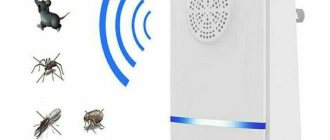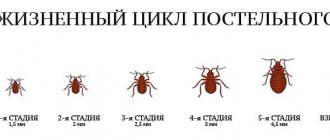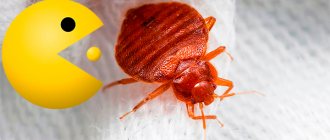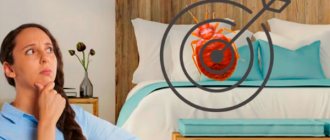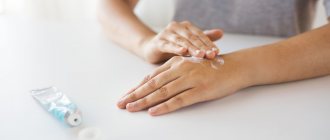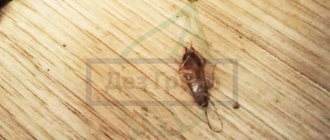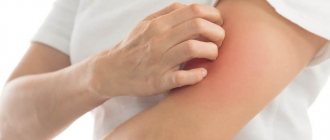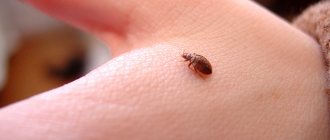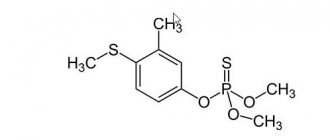As soon as bedbugs appear in an apartment, they immediately look for secluded places to live and a source of food. Cracks and crevices, secluded corners in furniture, the space behind baseboards and behind carpets become a refuge for them. And the source of food is people, whom the parasites visit at night for a portion of fresh blood.
Bedbug bites cause unpleasant symptoms, the most annoying of which is itching. Fortunately, there are many ways to get rid of it using pharmaceutical drugs or folk remedies.
Symptoms of bed bug bites
A bedbug bite can easily be confused with the bite of another insect, such as a mosquito, flea or midge. However, some features allow you to determine with fairly high accuracy which particular parasite has tasted your blood. If a person is bitten by bedbugs:
- small round red lumps appear on the body, in the center of which you can see a tiny dot - the puncture site;
- the skin around the bites swells slightly;
- if you press on the seal, you may feel a slight pain;
- bite marks are most often grouped in groups of 3–5 pieces, located at a distance of 1–4 cm from each other, and arranged in a path;
- bites are found on the body in the morning (since bedbugs go hunting at night);
- the skin at the site of the bites itches.
Bites
The location of the bites will also help identify the attackers as bedbugs - most often they appear on open areas of the body - neck, arms, legs, stomach, lower back.
Causes of itching
When bed bugs bite a person, the insect's saliva enters the bloodstream, which contains many substances, including an anesthetic. It is thanks to its analgesic effect that a person does not feel anything at the time of the bite.
The immune system immediately reacts to a foreign protein (parasite saliva) that has entered the body and begins to fight it. Antibodies begin to be produced, which rush to the site of the bite to eliminate suspicious substances. Immunoglobulins neutralize the allergen, but the result is redness, swelling and itching.
If you scratch the site of a bug bite, the inflammation intensifies, and in addition, pathogenic microorganisms enter the wound. In response, the immune system sends new batches of immune cells to the affected area, causing the itching to become more intense.
How to relieve itching after bedbug bites?
Bedbug bites itch the vast majority of people, with the exception of a very small number of lucky people - those whose bodies practically do not react to insects. Helps to get rid of itching:
- topical preparations (cooling, disinfectant, sedative);
- antihistamines (eliminate allergy symptoms, including itching);
- folk remedies.
Rinsing the wound with plenty of clean water, as well as a cold compress applied to the affected area, will help alleviate the condition. The use of medications is not always required, but if the itching is severe and it is difficult to resist scratching, it is worth anointing the bite site with ointment or cream.
How to distinguish bedbug bites?
Externally, bedbug bites are similar to the bites of mosquitoes, ants and other insects, but have several differences. Usually there are several affected areas on a person, since one insect makes 5-7 bites to get enough. The most favorite places for bedbugs are the back, neck, face, and the inside of the arms. They have a great sense of where the skin is thin and where blood vessels run close to the surface.
Since when bugs puncture the epidermis they release saliva with an anesthetic effect, their bites are usually not felt, and the consequences can only be detected at night. True, the larvae do not have an anesthetic substance, so their “activity” can be noticeable.
If you have been bitten, you need to deal with the original source of the problem, read in this article how to poison bedbugs yourself?
Bedbug bites are indicated by the following symptoms, which usually appear after a night's sleep:
- redness;
- swelling;
- severe itching;
- burning;
- painful papules, etc.
Usually the affected areas are very itchy, but you should not scratch them. Sometimes painful sensations occur. When an allergy develops, rashes, sneezing and even breathing problems may appear, but this is extremely rare.
Note! Traces of blood on bed linen also help to distinguish bedbug bites from other parasites, especially in cases of massive infestation.
How to treat bites on the body?
Ointments, gels and creams fight itching, relieve inflammation, and promote rapid healing of the skin at the site of the bite. Most often used for these purposes:
- Fenistil gel is one of the most effective remedies, quickly eliminates itching from bedbug bites and other insects, relieves inflammation (it is recommended to apply 2-4 times a day);
- Psilo-balm – relieves itching, reduces swelling and redness, the effect is noticeable after the first use;
- Asterisk is a well-known balm with a specific odor based on natural ingredients (essential oils and plant extracts) that effectively fights inflammation, relieves unpleasant symptoms, and has a disinfectant effect;
- Rescuer is another natural remedy, which contains essential oils, beeswax, plant extracts, vitamins, accelerates tissue regeneration, relieves burning and itching, and reduces swelling;
- Bepanten is a drug produced in the form of a cream or ointment that helps relieve swelling and speed up healing (can be used even for infants);
- zinc ointment – dries, relieves inflammation, promotes tissue regeneration;
- Elidel is a powerful drug that is prescribed in cases of severe skin reactions in the form of dermatitis, eczema, reduces inflammation, relieves swelling, itching, and promotes healing;
- Afloderm is an anti-inflammatory hormonal drug that helps eliminate the symptoms of an allergic reaction.
Afloderm
Taking antihistamines will help relieve itching, as well as reduce redness and swelling. Most popular:
- Tavegil;
- Suprastin;
- Cetrin;
- Claritin.
These remedies not only eliminate the symptoms of bites, but also help prevent unpleasant consequences, such as the development of hives or dermatitis. Before using medications, you should consult your doctor.
How to treat: medications
You can quickly remove the unpleasant consequences of meeting parasites at night with the help of medicinal ointments. Their main advantage is high efficiency, fast action and ease of use. The following drugs are best suited:
- Psilo-balm. Reduces swelling and also effectively eliminates itching, removes unpleasant symptoms of burning and discomfort.
- Fenistil-gel. A gel containing dimethindenate maleate as the main active ingredient will help get rid of irritation. Thanks to him, the medicine does an excellent job of eliminating unpleasant symptoms.
- Afloderm. It has anti-inflammatory and anti-allergenic properties, but it contains hormones, so you should consult your doctor before starting treatment.
- Akriderm. The medicine has antiallergic and antifungal effects. In addition, the drug stops inflammatory processes and prevents the spread of infection. It is recommended to apply it 3-4 times over several days.
- Hydrocortisone ointment. A hormonal drug that is effective for severe allergic reactions.
At home, you can use “Zvezdochka” balm based on essential oils. “Rescuer” ointment is also suitable, as it eliminates symptoms and speeds up the process of skin restoration. Mothers of small children can use Bepanten cream. It relieves swelling and irritation well, and also improves the regeneration of skin tissue.
If bedbug bites cause an allergic reaction, then you need to take an antihistamine, for example Suprastin or Diphenhydramine. If you experience severe pain, you can take a painkiller tablet - Aspirin, Ibuprofen, Ketanov, or others.
Note! If the effects of parasite bites do not disappear for a long time, consult a doctor for help. He will be able to choose the optimal treatment.
What to choose: ointment, gel or cream?
Topical medications that help relieve symptoms resulting from bedbug bites are available in the form of ointments, gels and creams. When choosing what to anoint bedbug bites to prevent itching, you should take into account some features of various forms of preparations for external use:
- gel is a water-based product that is quickly absorbed, gives almost instant relief, but has a rather short-lived effect, which is why it must be applied more often than others (an additional advantage is that the product does not leave stains on clothes);
- cream - contains fats, the effect of application does not appear immediately, but quite quickly, lasts longer than the gel;
- ointment is a product based on fatty components, it takes a long time to be absorbed, which is why the result does not appear immediately, but it lasts for a long time.
If the bites are very itchy, you should use the gel. However, ointments and creams are considered preferable in the case of treating serious skin lesions.
Folk remedies
There are many folk methods that effectively remove all the consequences of night acquaintance with parasites.
Baking soda
A baking soda paste will help remove rashes, redness and swelling. Depending on the area of skin affected by bedbugs, you need to take a couple of tablespoons of regular baking soda. Add some clean water to it to make a thick paste. Place the prepared mixture on the epidermis and leave for a while (10-15 minutes). After which, rinse with warm and clean water.
Aloe
The folk “healer” - aloe - helps to cure bedbug bites quite quickly. The plant has pronounced antibacterial, anti-inflammatory, and wound-healing properties. Helps relieve itching and eliminate swelling. Using aloe is simple:
- The leaf of the thorny plant must be washed well. For treatment, it is advisable to take large leaves more than 15 cm long, as they contain more useful substances.
- Next you need to cut the sheet lengthwise.
- All that remains is to anoint the damaged skin with aloe juice.
- The procedure must be repeated several times a day.
The duration of treatment usually continues until the symptoms completely disappear.
Garlic
Another easy way to forget about bed bugs is to use garlic. The plant contains substances that have an antiseptic effect. In addition, garlic is effective in eliminating rashes and other symptoms.
Peel a clove of garlic (or several), then cut lengthwise. Rub the inside of the bite marks. Repeat the procedure up to three times a day. Garlic compress is considered more effective. To do this, peel the cloves and grate them or pass them through a press. Place the pulp on clean gauze so that it is well saturated with juice. Apply it to your body for 15–20 minutes.
Onions are also an effective folk remedy for treating bites. Use it in the same way. You can simply wipe the affected areas with the plant or make a compress, like using garlic.
Decoction of medicinal herbs
You can also get rid of rashes on the body using a decoction of medicinal herbs. St. John's wort is most often used, but chamomile, sage and other herbs that have anti-inflammatory and healing properties are also suitable. To prepare the solution, you need to pour boiling water over a tablespoon of the herb. Cover with a lid and leave for a while. It should be strained before use.
Soak a cotton pad or gauze (bandage) folded in several layers in the broth and wipe the problem areas. To enhance the effect of medicinal herbs, you can drop a little fresh lemon juice onto the disc.
Note! Decoctions of medicinal herbs can be added to water when taking a bath.
Essential oils
Essential oils will help get rid of spots, itching and other symptoms, as well as prevent the appearance of new bites. For ease of use, you should mix them with fish oil, and then apply homemade ointment to the skin affected by bedbugs. You can use clove, lavender, orange, lemon, tea tree or other essential oil.
It is imperative to treat bed bug bites, as the consequences can be unpleasant. When scratching, it is quite easy to cause an infection, and then inflammation and even suppuration will be difficult to avoid. It is especially urgent to take action if parasites have bitten a child. Children find it difficult to stop themselves from scratching. If you are sleeping in a place where bedbugs may be present, take preventive measures. Use essential oils or perfume to repel overnight guests.
When should you consult a doctor?
Most often, bedbug bites do not require the help of a specialist and go away on their own, and topical medications help speed up healing.
You should seek medical help if the reaction to insect bites becomes more pronounced - redness and swelling intensify. The doctor will tell you how and what to treat bedbug bites in cases where a person’s wounds do not heal for a long time, become inflamed, and the itching becomes more intense.
In addition, you should definitely seek medical help if a person bitten by bedbugs develops a severe allergic reaction. Such cases are quite rare, but sometimes parasite bites lead to symptoms such as:
- severe weakness;
- nausea;
- cardiopalmus;
- shortness of breath, difficulty breathing;
- Quincke's edema.
Dyspnea
In the most severe situations, anaphylactic shock may develop, in which it is necessary to urgently call an ambulance.
Ointments and gels for the treatment of bedbug bites
2015-06-11 City Disinfection Station
When starting self-treatment and using medications at your own discretion, it is important to make sure that the bite actually belongs to a bedbug. A person who has never encountered such a problem can easily think that he has been bitten by a mosquito or other insect.
Symptoms of bedbug bites:
- redness of the skin;
- swelling of a round shape;
- itching;
- in rare cases, allergic reactions occur;
- a clear path of bites - from three to five red round spots at a distance of two to four centimeters.
Note: the main differences from a mosquito bite are pain and clear outlines of the bite site.
How to treat bedbug bites
You can combat the consequences of bed bug bites with the help of special ointments, gels and creams, or use traditional medicine recipes.
What are the remedies for bedbug bites?
Each product contains a base in which the active substance is dissolved in a certain proportion.
- Gel. The base of the drug is aqueous, due to which the active substance dissolves completely. After use, the drug is easily washed off from skin and clothing.
- Ointment. In such a medicinal product, the active substance does not completely dissolve in the base. This is explained by the fact that ointments have a fatty base, due to which the product is absorbed into the skin more slowly and has a longer effect.
- Cream. It contains less fat compared to ointment, however, traces of the medicine are quite difficult to remove from clothes.
Note: for dry, flaky skin, and also if crusts have already formed after bed bug bites, it is better to choose ointments and creams. For normal skin with slight redness from bites and for weeping wounds, a gel is suitable. When choosing a remedy for treating bed bug bites, it is important to carefully study the indications for use and contraindications.
The most effective drugs against bedbug bites
Bedbugs are blood-sucking insects such as mosquitoes. To treat their bites, you can use popular medications that are effective against parasite attacks. Fenistil gel . This is an effective antipruritic drug, the active substance of which (dimetindene maleate) blocks the receptors responsible for the formation of pustules, itching and inflammation. The drug is prescribed for insect bites, various allergic reactions in the form of swelling and burning.
Fenistil is available not only in the form of a gel, but also drops and emulsions. Absorbs well into the skin. When using it, the bites need to be lubricated 2-4 times a day.
Note: Fenistil gel is not prescribed to children under one year of age.
Psilo-balm (gel) . The active ingredient of the drug is the powerful component diphenhydramine (diphenhydramine). The substance has a complex effect:
- blocks receptors responsible for itching;
- reduces vascular permeability;
- eliminates swelling of soft tissues;
- cooling effect.
The gel is used when it is necessary to quickly eliminate pain after a bite and dry out the crusts.
Elidel (cream) . The remedy is used if, as a result of an insect bite, serious complications arise in the form of atopic dermatitis or eczema. The active substance of the cream - pimecrolimus - has very powerful anti-inflammatory and regenerating effects. It is not recommended to apply it to damaged areas of the skin where an infection (fungal or bacterial) develops.
Note: the drug can be used by children from three months of age.
Bepanten (cream and ointment). This drug is made on the basis of the B vitamin - dexpanthenol. Thus, the product effectively restores and heals damaged areas of soft tissue and skin, and also moisturizes them. However, the drug does not have an anti-inflammatory effect and eliminates itching. Bepanten is most effective for moderate skin damage from insect bites: minor redness and slight swelling.
Note: the peculiarity of the product is that it is safe even for newborns. It is often used as a treatment and preventive measure against dermatitis and diaper rash.
Ointments based on propolis. When using such medications, it is important to remember that propolis is a strong allergen, especially when it comes to treating bites in children. Ointments are used with extreme caution if the patient already has an allergy to pollen. Treatment with propolis causes cross-allergy.
When to see a doctor
Ointments, creams and gels can treat minor symptoms of bedbug bites such as itching, slight swelling and redness. If the consequences of insect attacks are more serious, it is necessary to take antihistamines, for example, Loratidine.
It is not recommended to postpone a visit to the hospital if the body has reacted acutely to a bug bite:
- breathing becomes difficult;
- the temperature rises sharply;
- chills appear;
- swelling spreads to the entire limb or becomes extensive;
- the rash spreads to the whole body;
- nausea develops;
- loss of consciousness.
Bee and wasp stings typically have similar symptoms, but if a person is susceptible to allergic reactions, bed bug attacks can also cause similar complications.
Note: if the body reacts severely to insect bites, you should always have an ampoule of Dexamethasone in your first aid kit.
Traditional methods of treating bedbug bites
If there are no medications suitable for the action in your medicine cabinet, traditional methods of treatment will come in handy:
- taking activated carbon;
- treating affected areas of the skin with a baking soda solution;
- treating bites with aloe juice;
- washing wounds with a decoction of St. John's wort, just infuse a tablespoon of dry herb in a glass of boiling water, moisten cotton swabs and wipe the bite areas;
- treating affected areas of the skin with strong brewed tea;
- To relieve itching and reduce swelling, you can apply a piece of ice to the bite.
It is important to closely monitor the reaction of the skin and body to the drugs used. In case of any complications, you should stop treatment on your own and seek the help of a specialist.
Author of the material: Vladimir Egorov
Disinfector Experience in the field for more than 4 years
How long do bedbug bites last?
It is very difficult to say how long it will take for the bite marks to completely disappear. This depends on many factors, including the individual characteristics of the bitten person, his predisposition to allergies, and the number of bites. It also matters whether the person scratched the bites or was able to restrain himself and endure the itching.
On average, a bug bite goes away in 1–3 days. But for some people everything happens much faster, and by the morning there are no traces of the night attack of parasites left on the body. Others develop severe inflammation, redness and swelling, and the bite mark goes away within 10 to 15 days, and in rare cases longer.
